Nobody freak out, but I’m going to write a post. About a dress. That I made! I have wanted to make this particular costume for about 20 years, which is why I am blowing the dust off my keyboard and doing this. I’d like to share some of the making on social media, and I’d like to be able to share more than just photos. So, let’s see if I remember how to do this?
I’ve shared the story of the real-life Countess of Castiglione, Virginia Oldoïni (1837-99), as well as my own personal interest in her, in a review I wrote for Frock Flicks. As I wrote there:
The Countess of Castiglione was Italian; she was married off at age 17 to the count, who was 12 years older. She was renowned for her beauty, which helped take her life in a couple of interesting directions. She got involved in the movement for Italian unification, moving to Paris in 1855 (initially with her husband) to try to gain political support from Napoleon III. She ended up becoming Napoleon’s mistress, and her husband separated from her. She became famous for wearing amazingly gorgeous and inspired costumes to the fancy dress balls that were then popular, and collaborated with French photographers Mayer and Pierson to create these insanely cool, artistic photographs of herself that were meant to recreate important moments in her life, many of which focused on fancy dress costume. She returned to Italy for a few years, then moved back to Paris where she lived in seclusion until the 1890s, when she did another series of weirdly arty photographs.
I’ve been a fan for over 20 years, and I played the countess at the Dickens Fair, where I had to make an “everyday” (i.e. not fancy dress) day dress, which I posted a bit about. But the costume of hers that I have always been obsessed with is this 18th century fancy dress/masquerade costume from the mid-1860s:
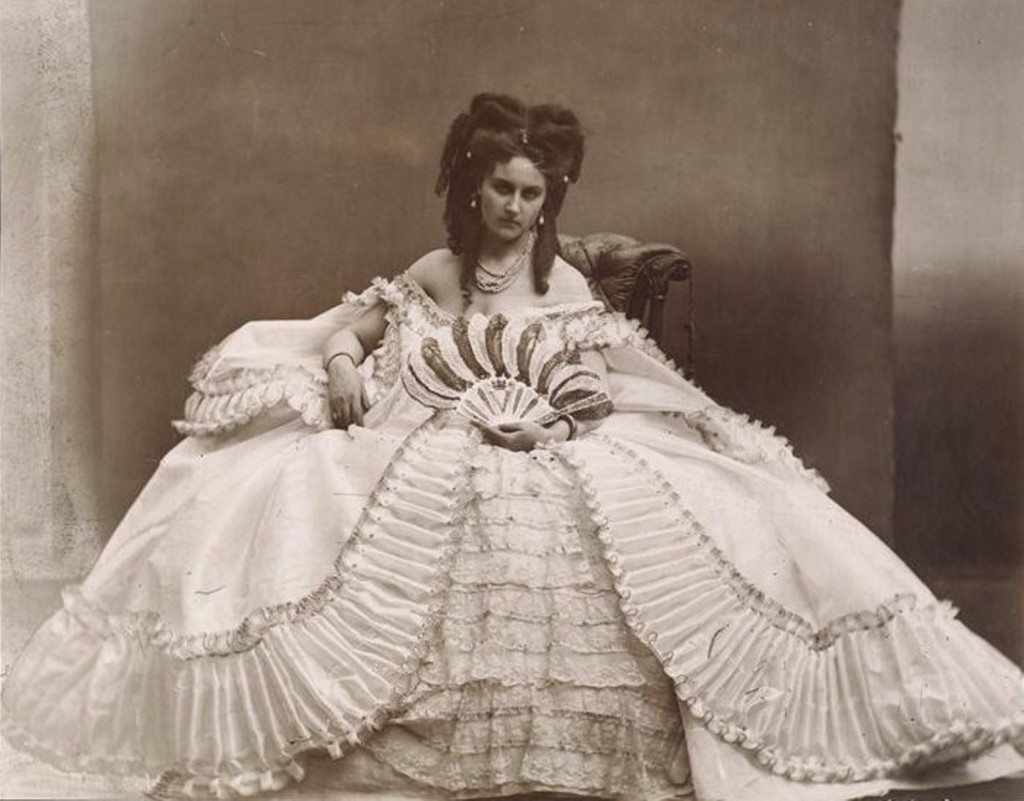
There’s so much I love about this. First, the over-the-top take on 18th century, which is my first love. The lushness of All That Fabric. The INSANELY interesting, very 1860s but not in a butterchurn-y way hair. And the intense gaze — she looks like the best kind of evil sorceress.
I’ve thought before about making this costume for Costume College, because it’s not something you would wear to most occasions. But even Costume College didn’t seem big enough for such an amazing costume! Plus, it would be huge and annoying to dance in.
Well, I finally made it to Carnevale in Venice this past February (back when we were able to do such fabulous things! Remember that time?), and I knew I HAD to make this, finally. I mean, VENICE! Not only was the countess Italian, but Carnevale is about over-the-top, tweaked and twisted and arty costumes, not just showing up in your standard ballgown. And I was invited to an amazing party with the theme of “Royal Favorites,” i.e. dress as the favorite of a king/queen/emperor/etc., which is perfect for the countess. And so, it began.
First, the fabric. The countess was an early pioneer in photo alteration, and in fact she colorized many of her photos using different variations. Here’s some of the ideas she had for this dress (note: I am just now noticing the bows on the petticoat, only because she colored them here):
![[Variations on the "Elvira" Dress] by Pierre-Louis Pierson, 1861–67, Metropolitan Museum of Art](http://demodecouture.com/wordpress/wp-contents/uploads/2020/10/main-image-762x1024.jpeg)
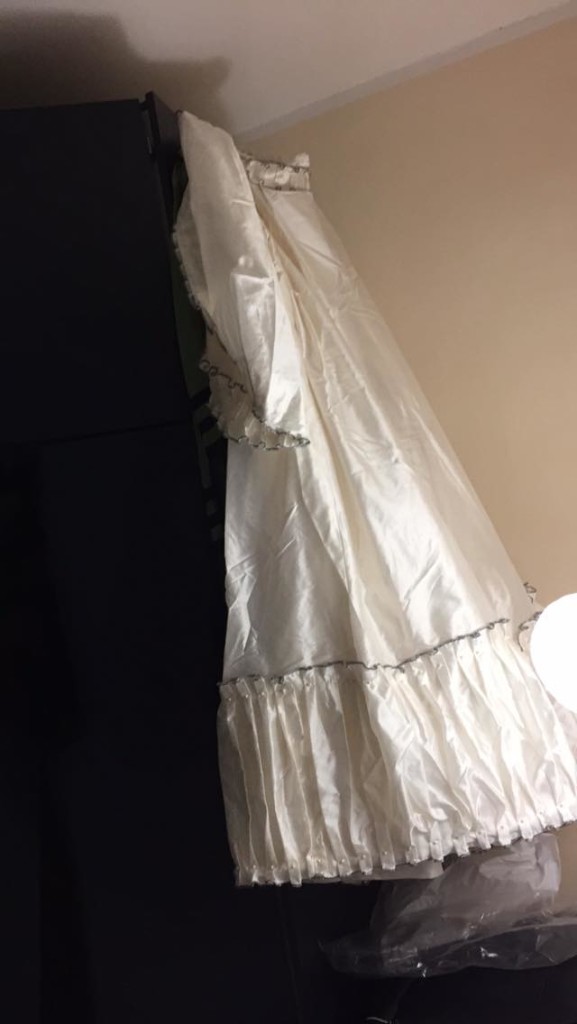
One of the best things about the countess is the many, many photos she had taken of herself. And this particular costume is quite well documented, although given the quality of the early photos, there’s still some guesswork involved. But I managed to find a number of photos that gave me a lot of information.
The fact that some of the photos call it a “pleated peignoir” let me know that it’s a loose gown, kind of like a robe volante (the full, pleated, unfitted gown fashionable in the 1720s-30s):
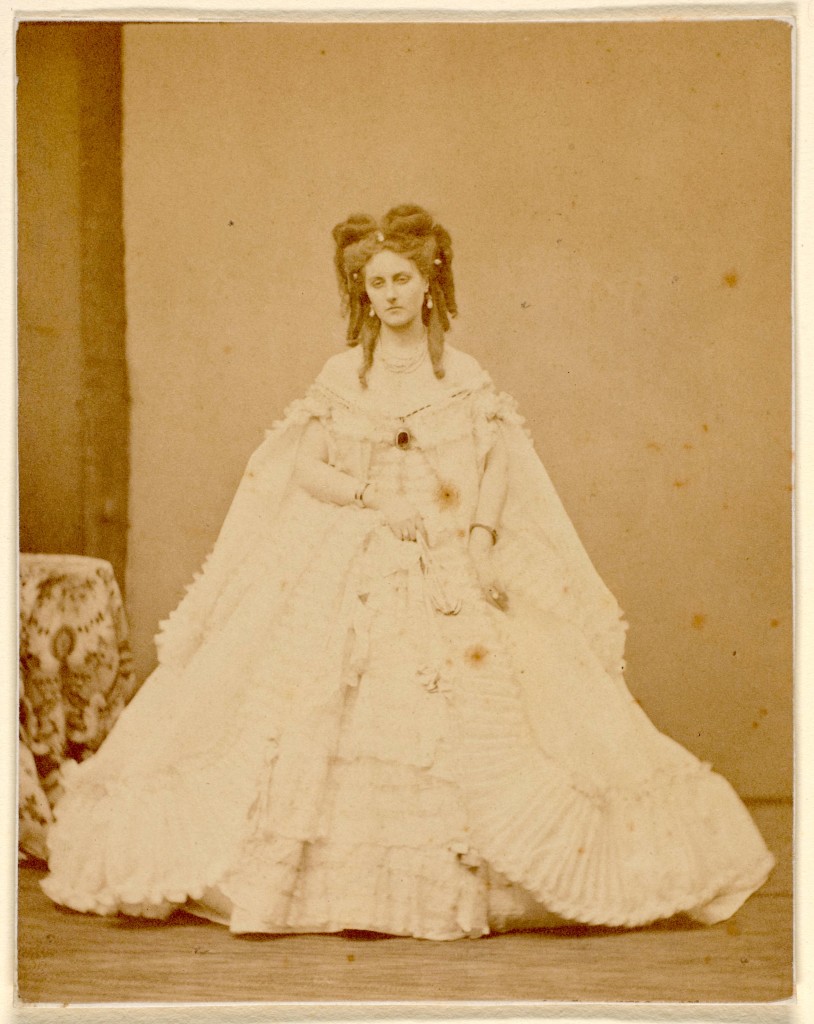
Notice how there’s no fitting around the waist, and the pleated trim along the center fronts is unbroken from neckline to hem:
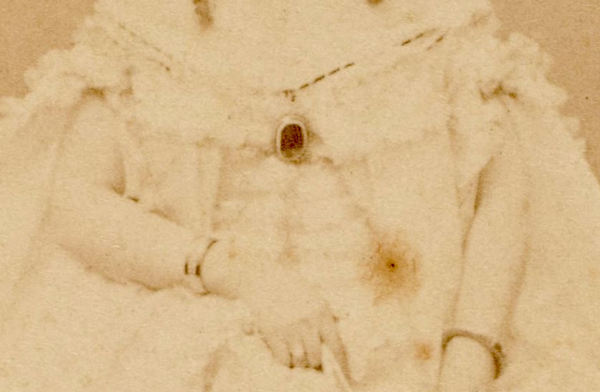
Here again you can see the unbroken line — the gown is clearly not stitched down to any lining in the torso:
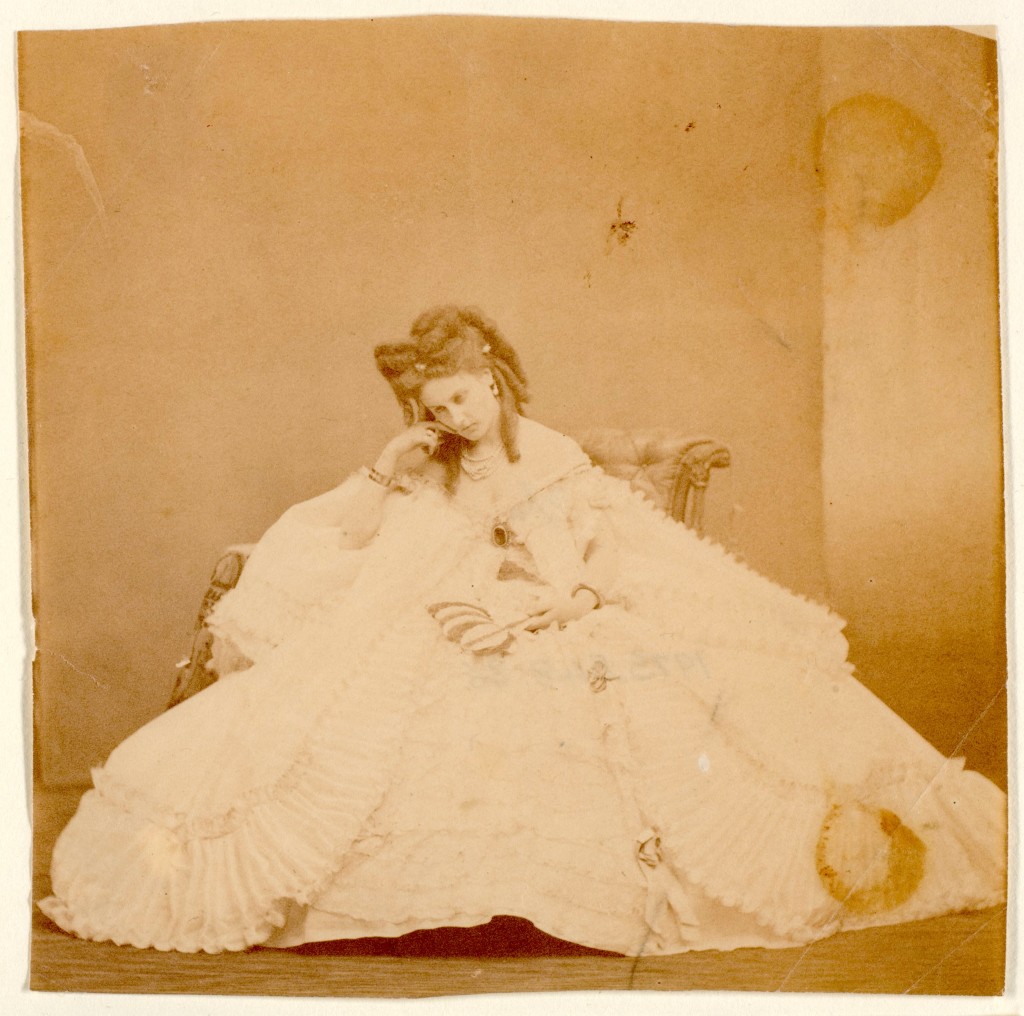
Here’s a robe volante, for comparison:
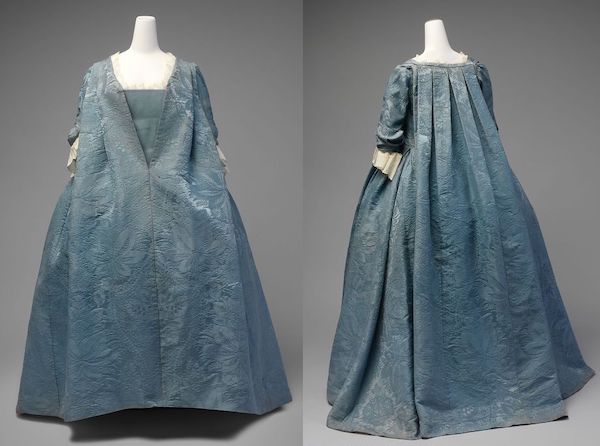
I decided to change this. I’m a curvy girl, and while this dress is basically a giant merengue, I wanted SOME kind of fitting. So I ended up giving it a waist seam in front, more like the later robe à la française, although because I was working over a Victorian corset, I went full princess seams as they would have cut this in the 19th century.
I started with a fitted lining with bones at the seams, as I knew they would be needed to support the gown given the low neckline. I ended up cutting away some of the V waistline when I realized that there didn’t appear to be a “stomacher” effect under the robe:
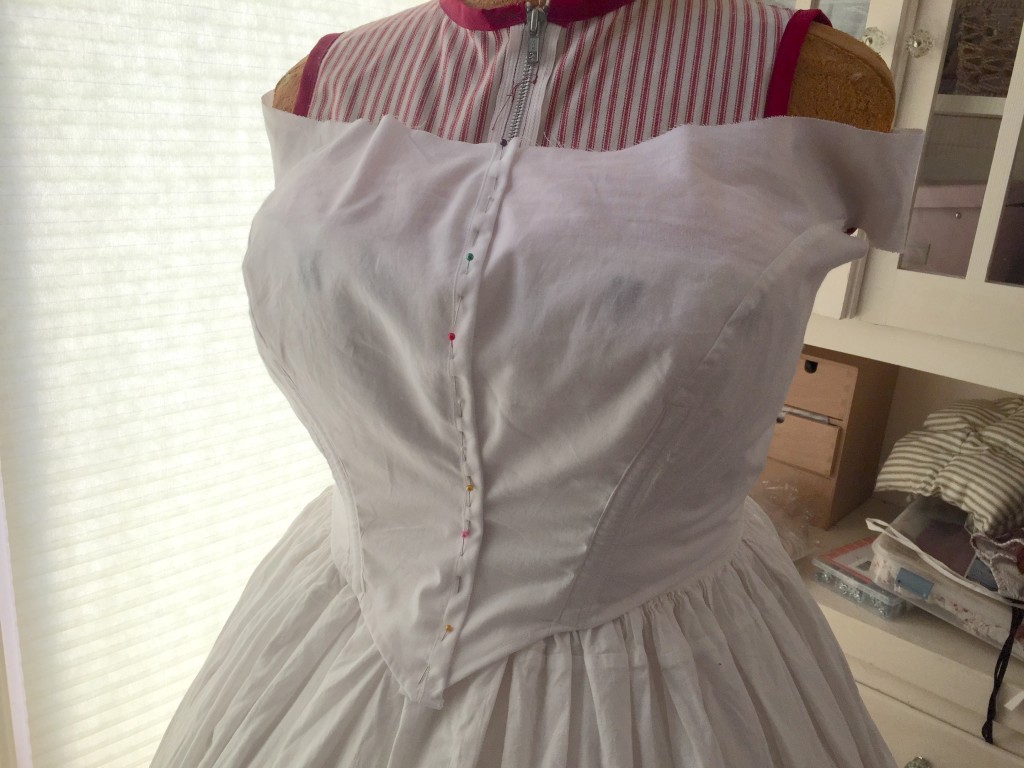

The back was hard to figure out. Clearly there’s a VERY low neckline in back (the countess was particularly proud of her shoulders), a train, and the pleated trim goes all along the hem:
![[Countess de Castiglione as Elvira at the Cheval Glass] by Pierre-Louis Pierson, 1861-67, Metropolitan Museum of Art](http://demodecouture.com/wordpress/wp-contents/uploads/2020/10/DP158941-1024x969.jpg)
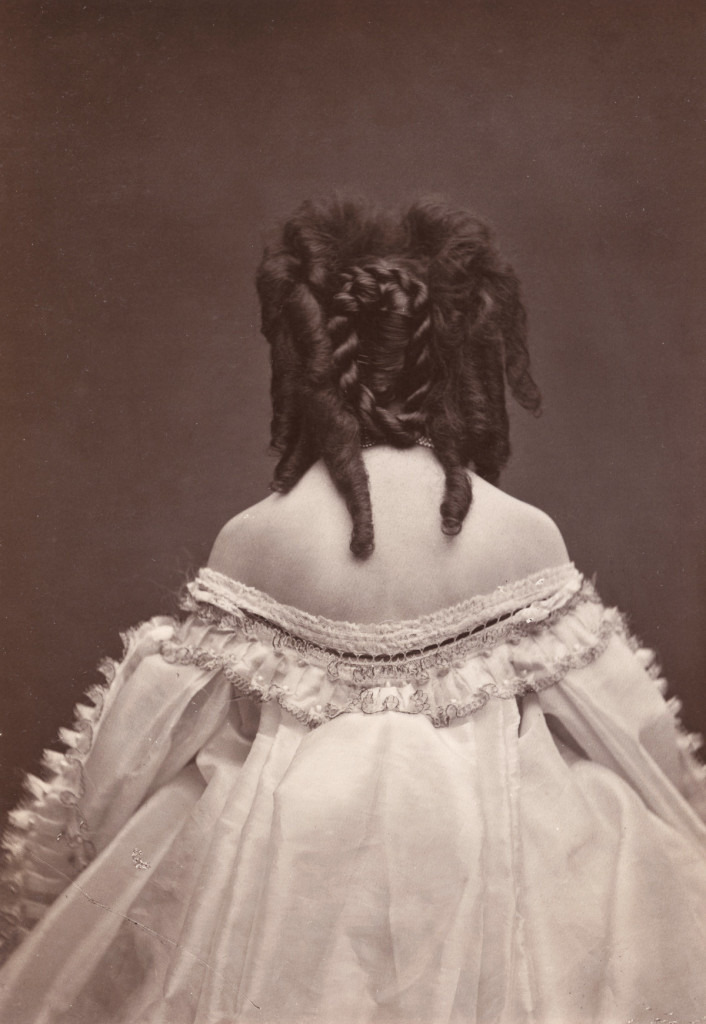
I did the same, although I skipped the train. I knew I would be wearing this at a crowded party, and I didn’t want to deal with having my (white!) hem stepped on all night. I did give myself a heart attack one evening when I walked by and thought, “Oh my god, I made the back pleats wrong! There’s supposed to be an inverted pleat in the CB!” Luckily I rechecked my sources and was relieved to discover I had done it right.


Here’s the finished dress, before trimming and sleeves:
Next up was to start the trim. First, that clear back shot was a life saver in that I could really figure out what was going on with the trim:

I bought SO MANY TRIMS, Y’ALL. I could NOT decide what color/effect I wanted. I couldn’t find anything with the two-tone effect that I liked. I really wanted a dark silver, but worried that wouldn’t go with my peachy-undertoned ivory, so bought a couple different gold and copper trims, and then a couple different silver. I finally decided to go with the silver, since that’s how I pictured the dress in my mind, and found a tiny silver braid on Etsy that worked, as well as pearls and vintage lace:
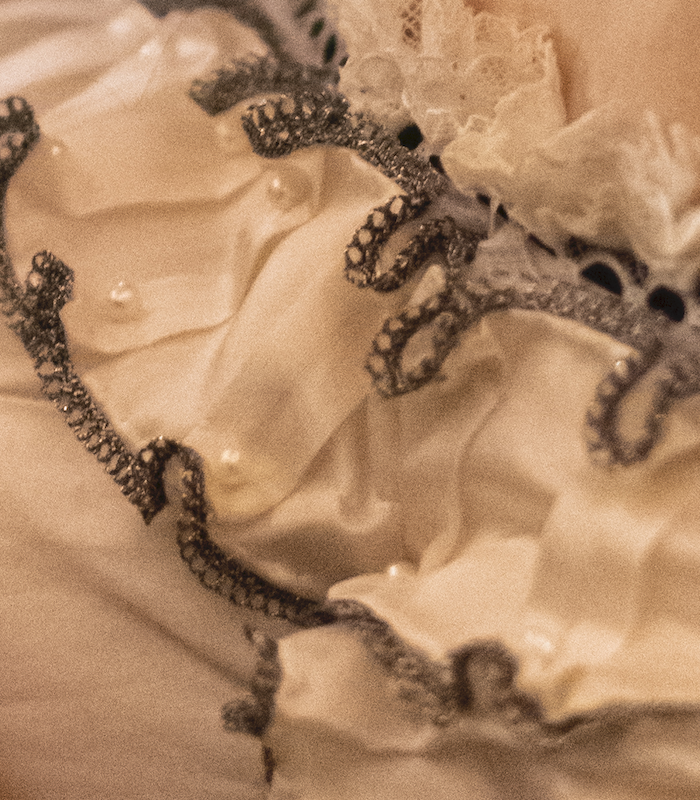
Then, I trimmed:
I had to use EVERY SCRAP to eke out enough fabric. This was one of the back hem ruches, so hopefully it doesn’t show given the placement and the pleating:
The sleeves took some definite parsing. From the photo above, I could see that there were pleats at the armhole in back, towards the interior. Looking at this faint photo, I decided that the sleeve was trimmed on the INSIDE, and then flipped back on itself:
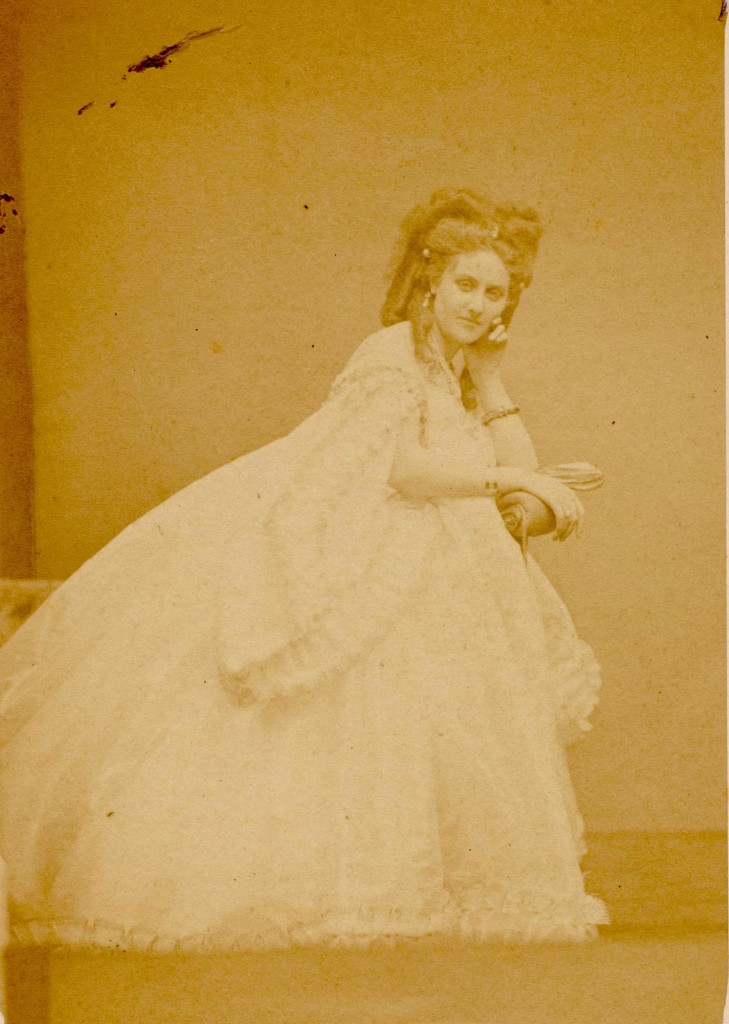

I patterned them as HA-UGE versions of pagoda sleeves, which is what I think they are, and tacked the interior back on itself:
The petticoat is actually three-row tiers of lace, with what I think is flat ribbon in between. I’m not sure how I missed those ribbon bows, except that this was the photo I spent a lot of time peering at, and you can’t see them here:
I found some various antique laces for the neckline and skirt, but I didn’t have enough of the skirt stuff. I ended up buying some flat nylon lace and was pleasantly shocked to find you CAN tea-dye nylon lace! It looked great after I’d done that. I didn’t have enough yardage to make the three-row tiers, so I went with two, using silk satin ribbon for the join.
The fan she carries in this photo survives at the Met! Which is SO cool. I had plans to try to make my own — I found lace appliques in similar shapes, and took the leaves off of an antique fan — but I ran out of time. In the end, it probably would have looked janky (I keep picturing a hot-glue nightmare), so it’s probably for the best — but I may try someday!
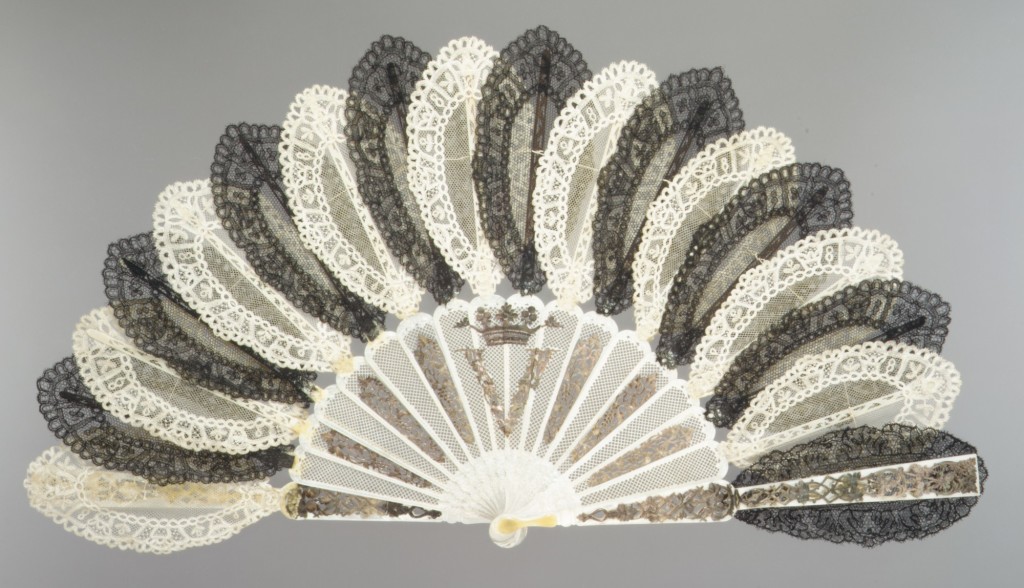
Of course, I HAD to have that hair. The real countess had blonde hair (which you can see in the colorized photo above), and she was also so into the 18th century that she was known for powdering her hair. I couldn’t pull off blonde, but I could do powdered… but I’ve always seen these photos in sepia in my mind, and dark hair just felt right. Once again, THANK YOU whoever took that back detailed shot, because I don’t know if I ever would have figured out the back otherwise. Here’s my working image board:
And my result. It was a little too wide at the sides, but I played with pinning it and wasn’t sure, so I ended up going with it. I wish my back twist was a little smoother, and may try to comb that out and retwist it at some point:
Because my BFF Trystan is the best, she helped me take some carefully posed photos in our palazzo before the event. I really wanted to try to recreate the original photograph as much as possible. Unfortunately my version of bitchface mostly looks like “sad dog” (I have a natural downturn to my mouth – resting bitchface!) and the smiley photos ended up much better.
And, I had a FAAAAABULOUS time:
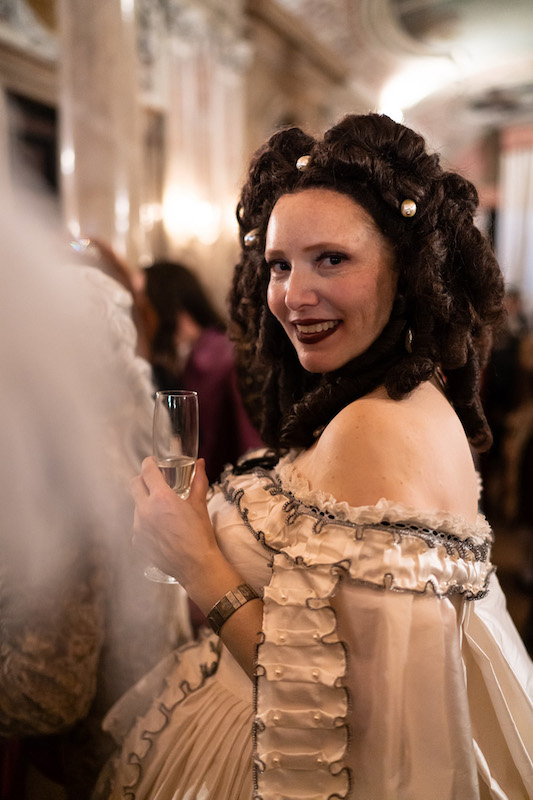






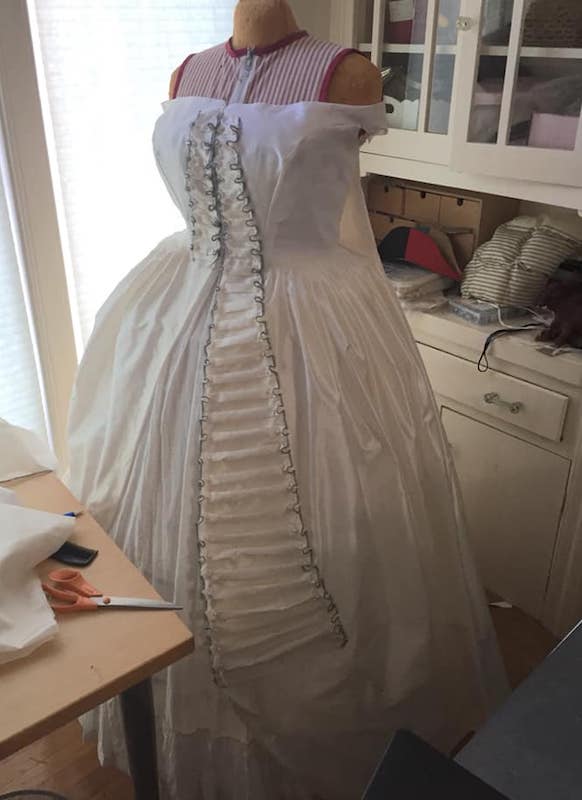


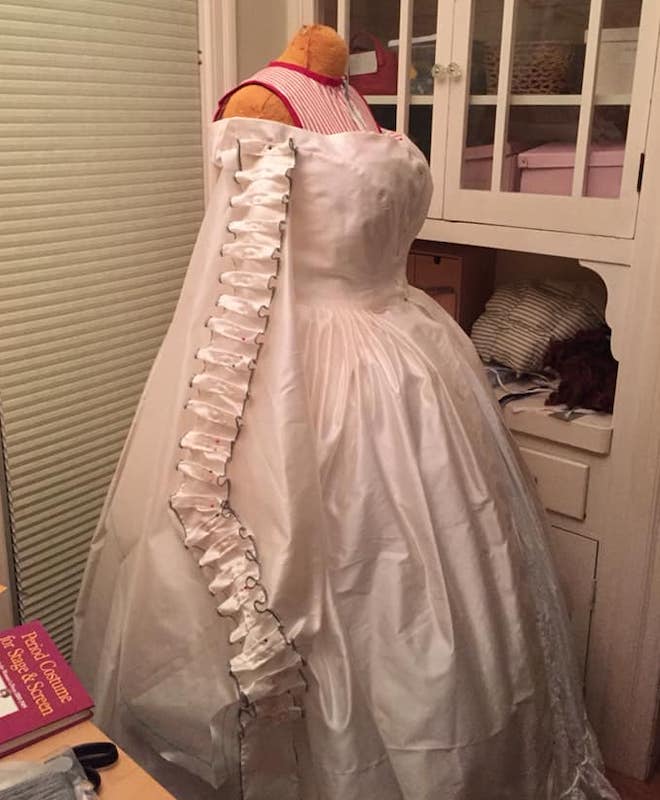
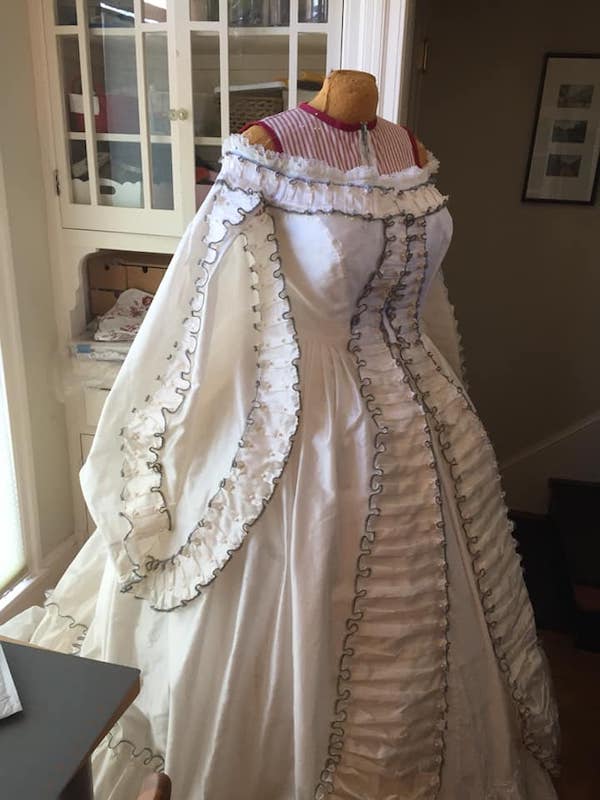




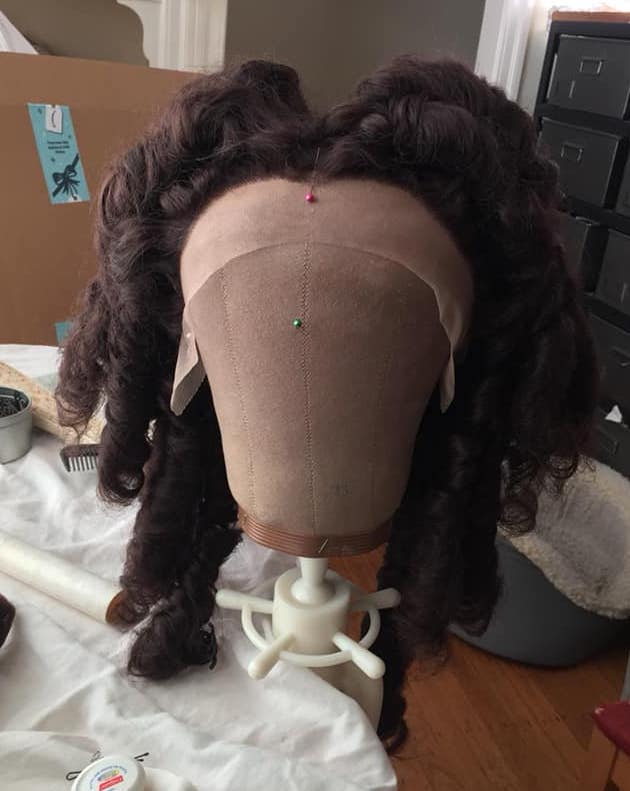


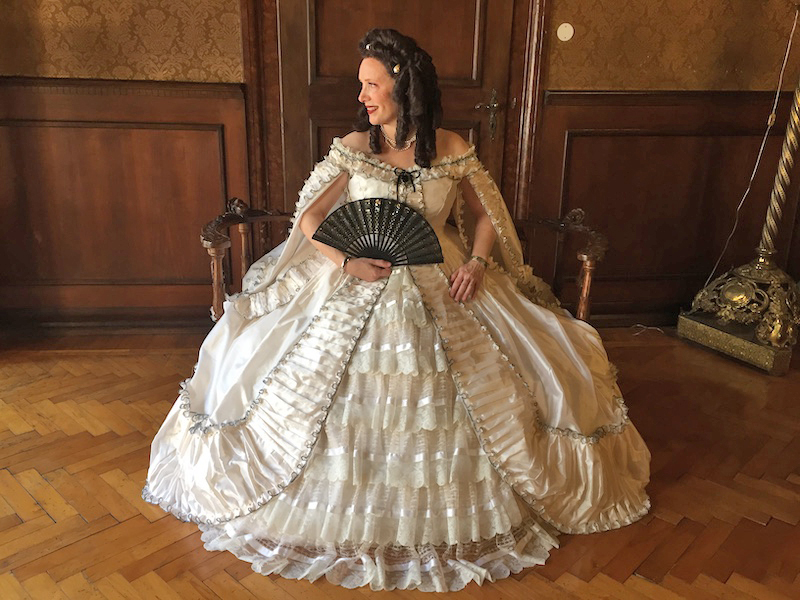
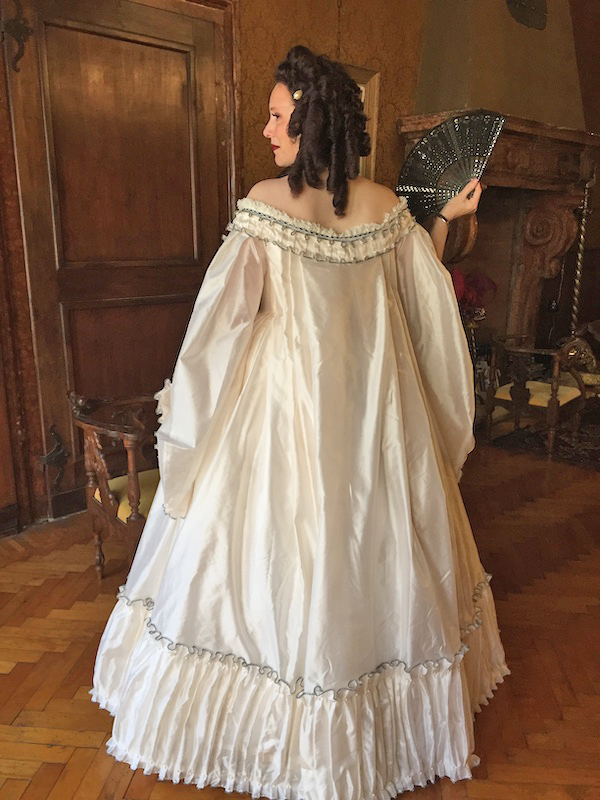
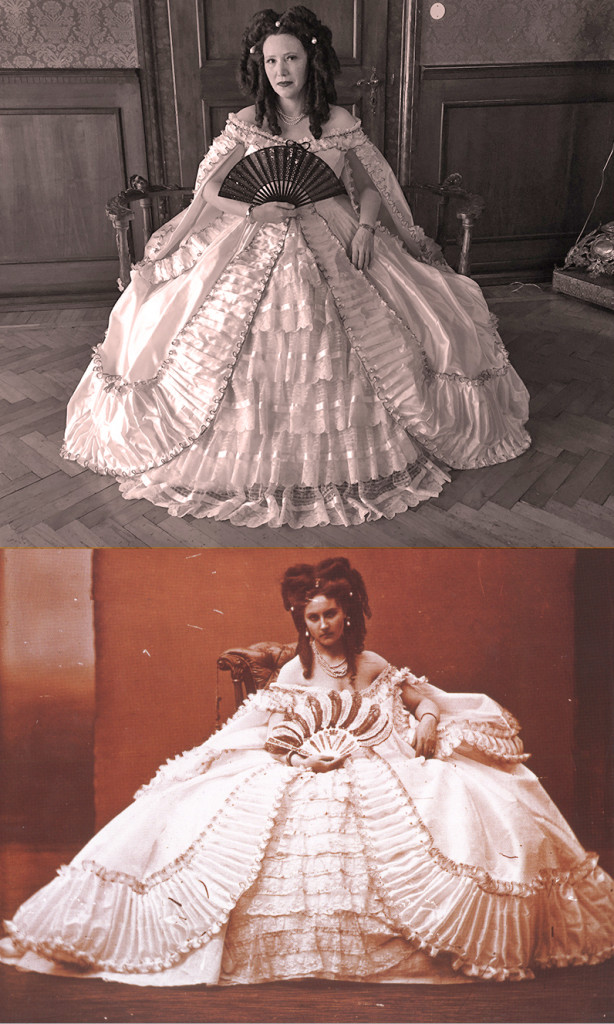
Not quite sure about the blonde hair, they look too dark in the surviving photo to be blond. I believe more in a brown tone.
Good point. She definitely colorized her hair blonde in that photo series I posted, but here’s a portrait of her with darker (powdered) hair: https://en.wikipedia.org/wiki/Virginia_Oldoini,_Countess_of_Castiglione#/media/File:Contessa_di_Castiglione.jpg
So I’m like a month late to this post, but OMG! What a fabulous gown! And what a wild and fun project. The trimming looks insanely good and the hair!!! Congrats, it all looks stellar.
This is such a cool project and it came out perfect! I also love you for writing a blogpost about it; I kind of miss those.. I mean, I love instagram and get lost there all the time, but there is just something so nice about an indepth blogpost like this.
Thanks – I kind of miss these too!